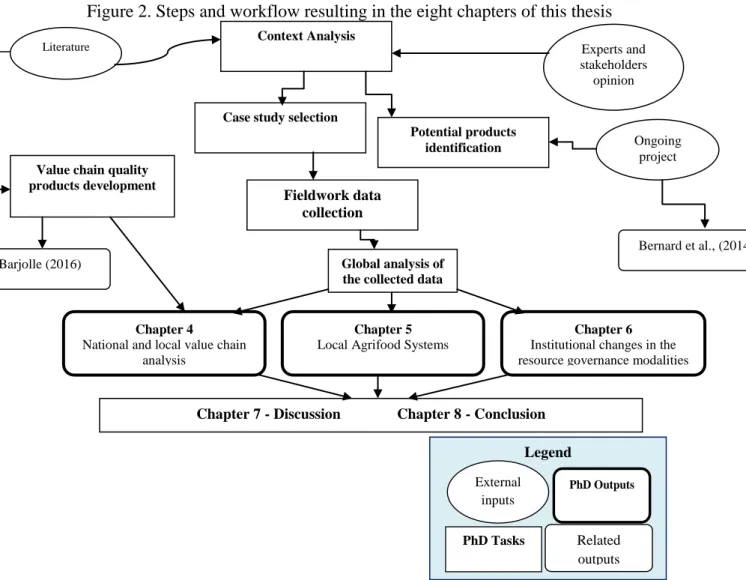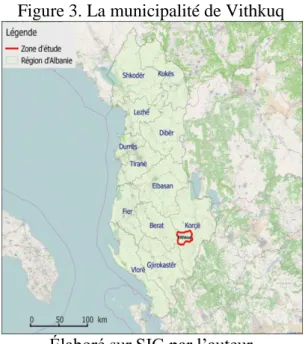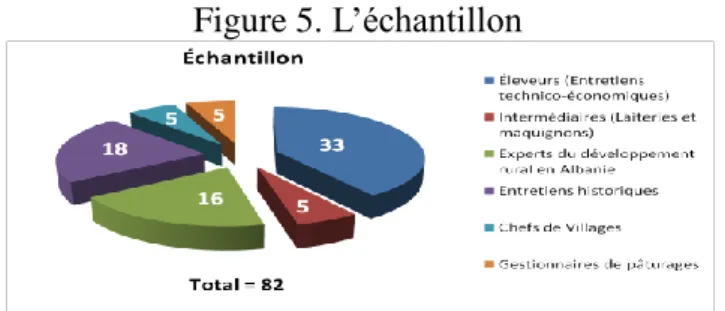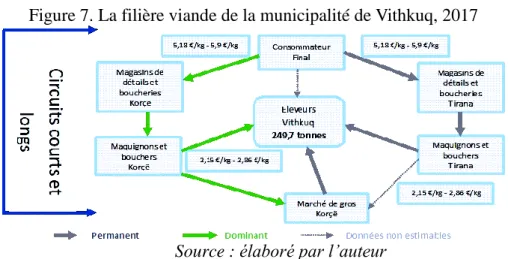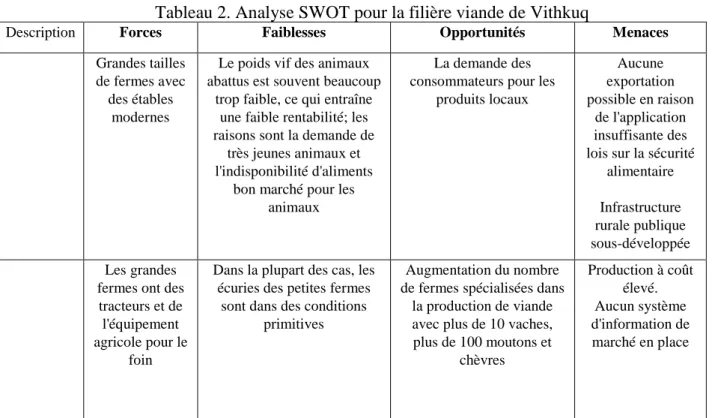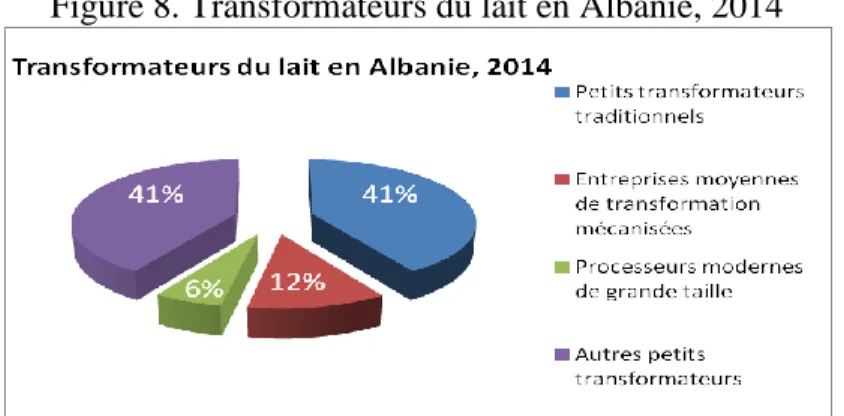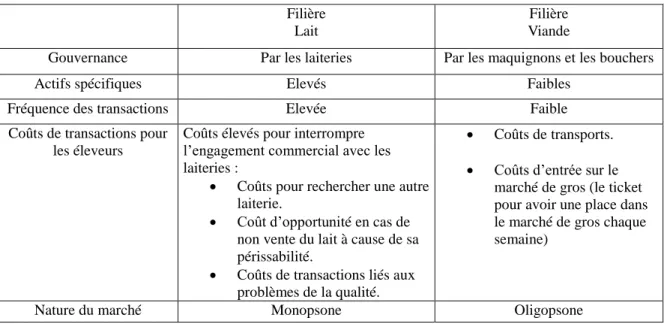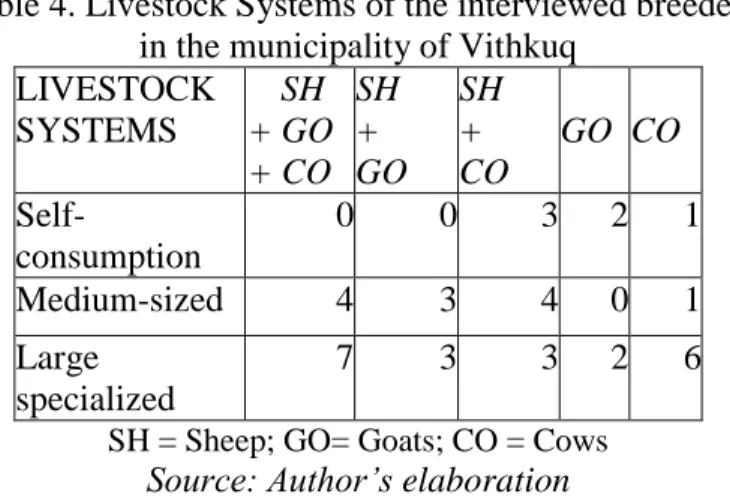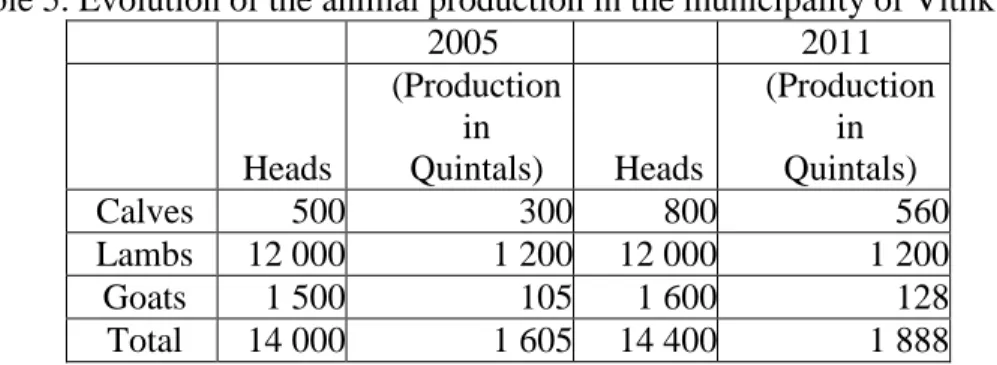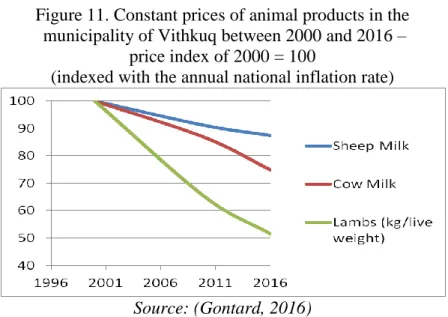1
THÈSE POUR OBTENIR LE GRADE DE DOCTEUR
DE MONTPELLIER SUPAGRO
En Sciences Économiques
École doctorale EDEG – Économie et Gestion
Portée par l’Université de Montpellier
Unité de recherche INNOVATION
Quality products valorisation for the Albanian mountains
territories. What conditions to improve endogenous rural
development?
Présentée par Florjan BOMBAJ
Le 14 novembre 2018
Sous la direction de Dominique BARJOLLE
Devant le jury composé de
Etienne MONTAIGNE, Professeur, MONTPELLIER SUPAGRO Président Giovanni BELLETTI, Professeur, UNIVERSITÉ DE FLORENCE Examinateur
Philippe JEANNEAUX, Professeur, VETAGROSUP Rapporteur
Armelle MAZÉ, HDR, Dr. INRA Rapporteur
Frédéric WALLET, Dr. INRA Examinateur
Dominique BARJOLLE, HDR, Dr. ETHZ Directrice de thèse
Jean-Marc TOUZARD, Dr, INRA Examinateur
3
Foreword
I’m very glad to present my thesis, entitled “Quality products valorisation for the Albanian mountains territories. What conditions to improve endogenous rural development?”
This thesis was written to comply with the requirements of “Grande Ecole Montpellier SupAgro” and the Doctoral School of Economic and Management (EDEG) from Montpellier (France), in order to obtain the title of Doctor in Economics. The process of research and writing of this thesis started in October of 2014.
This thesis is the continuation of my research started during my Master Research at Montpellier SupAgro, of my overall view of the integration of disadvantaged mountain territories and the important role of the collective action in order to identify the socio-economically vulnerable actors and improve their economic conditions. But also to the territorial identities which are essential to help governments implement public policies that promote sustainable and desirable development of marginalized rural communities.
The research work, due to numerous reasons, has not always been easy, but studying this theme in-depth was very interesting and enriching, personally and academically. Very fortunately, Dominique Barjolle, Jean-Marc Touzard, François Casabianca, Claire Cerdan, Theodosia Anthopoulou and François Lerin, in particular, were always available and able to answer my questions. A specific section will be dedicated to all acknowledgments.
This thesis is presented in the form of articles, with 3 parts corresponding each to the elaboration of one scientific article, encompassed in a set of 8 parts including a general introduction, discussion, and conclusion.
I hope that you will enjoy your reading!
Florjan Bombaj, Montpellier, 14 November 2018
4 (Avant-propos)
Je suis très heureux de vous présenter ma thèse de doctorat, intitulée « Valorisation des produits de qualité pour les territoires des montagnes albanaises. Quelles conditions pour améliorer le développement rural endogène ?».
Cette thèse a été rédigée selon les exigences d’obtention du diplôme de doctorat en Economie de Grande Ecole Montpellier SupAgro et de l’Ecole Doctorale Economie et Gestion (EDEG) de Montpellier (France). Le processus de recherche et d’écriture de cette thèse a commencé en Octobre 2014.
Cette thèse est la suite de mes recherches entamées lors de mon Master Recherche à Montpellier SupAgro, de ma vision globale de l'intégration des territoires de montagne défavorisés et du rôle important de l'action collective pour identifier les acteurs socio-économiquement vulnérables et ameliorer leurs conditions economiques. Mais aussi aux identités territoriales essentielles pour aider les gouvernements à mettre en œuvre des politiques publiques favorisant le développement durable et souhaitable des communautés rurales marginalisées.
Les travaux de recherche, pour de nombreuses raisons, n’ont pas toujours été faciles, mais étudier ce thème en profondeur s’est avéré très stimulant et enrichissant sur le plan personnel et académique. Fort heureusement, Dominique Barjolle, Jean-Marc Touzard, François Casabianca, Claire Cerdan, Theodosia Anthopoulou and François Lerin, en particulier, se sont toujours montrés disponibles et à même de répondre à mes questions. Une section sera spécifiquement dédiée à tous les remerciements.
Cette thèse se présente sous la forme d’articles, avec 3 parties correspondant chacune à l’élaboration d’un article scientifique, s’insérant dans un ensemble de 8 parties incluant notamment une introduction, discussion, et conclusion générale.
En vous souhaitant une bonne lecture !
Florjan Bombaj Montpellier, 14 Novembre 2018
5
Table of content
FOREWORD 3 (AVANT-PROPOS) 4 ABBREVIATIONS 9 LIST OF TABLES 10 LIST OF FIGURES 11 ACKNOWLEDGMENTS 12 (REMERCIEMENTS) 13 ABSTRACT 15 (RESUME) 16 EXTENDED SUMMARY 18 (RESUME APPROFONDI) 22PART 1: GENERAL INTRODUCTION 27
(PARTIE 1 : INTRODUCTION GENERALE) 29
PART 2: STATE OF THE ART 32
ABSTRACT 32
(PARTIE 2 : ETAT DE L’ART) 33
(RESUME) 33
2.1 THEORY OF TRANSACTION COSTS AND VALUE CHAIN 34
2.2 THE LOCALISED AGRIFOOD SYSTEMS (LAFS) 36
2.2.1 LAFS and farming systems approach 37
2.2.2 Identifying the territorial resources issues of a given territory 38
2.3 THE COMMON TERRITORIAL RESOURCE AND ITS GOVERNANCE 39
2.3.1 Defining the common 39
2.3.2 The territorial quality rent 40
2.3.3 Collective governance and market access 41
2.3.4 GIs essential to preserve the value potential of products 42
PART 3: METHODOLOGY 44
ABSTRACT 44
(PARTIE 3 : METHODOLOGIE) 45
6
3.1 PROBLEM STATEMENT 46
3.2 RESEARCH OBJECTIVES 46
3.3 THE RESEARCH QUESTIONS 47
3.4 THE ALBANIAN CASE STUDY 48
3.5 APPROACH, METHODS AND PLAN OF THE THESIS 50
PARTIE 4 - ARTICLE: FREINS ET OPPORTUNITÉS AU DÉVELOPPEMENT DES PRODUITS
DE QUALITÉ, CAS DES FILIÈRES PASTORALES - VITHKUQ, ALBANIE 53
ABSTRACT 53
(PART 4 - ARTICLE : Brakes and opportunities for the development of quality products, the case of pastoral value
chains - Vithkuq, Albania) 54
(RESUME) 54
4.1 INTRODUCTION 55
4.2 CONTEXTE DE LA RECHERCHE 55
4.3 CADRE THÉORIQUE ET QUESTION DE RECHERCHE 57
4.4 MATÉRIEL ET MÉTHODES 58
4.4.1 Matériel 58
4.4.2 Méthode 58
4.5 RÉSULTATS 59
4.5.1 Dynamique de la filière lait/fromage 59
4.5.2 Dynamique de la filière viande 60
4.5.3 Initiatives collectives de valorisation des produits locaux 61
4.6 DISCUSSION 62
4.7 CONCLUSION 66
4.8 REMERCIEMENT 67
TRANSITION WORDS: FROM THE FIRST TO THE SECOND ARTICLE 68
(MOTS DE TRANSITION : DU PREMIER AU DEUXIEME ARTICLE) 69
PART 5 - ARTICLE: FAMILY FARMING IN THE ALBANIAN MOUNTAINOUS AREAS: LOCAL AGRO PASTORAL FARMING SYSTEMS AND MARKET INTEGRATION
PERSPECTIVES 70
ABSTRACT 70
(PARTIE 5 - ARTICLE : Agriculture familiale dans les zones montagneuses albanaises: systèmes d'agriculture
pastorale locaux et perspectives d'intégration des marchés) 71
(RESUME) 71
5.1 INTRODUCTION 72
5.2 RESEARCH CONTEXT AND QUESTIONS 73
5.3 METHODOLOGICAL APPROACH 74
5.4 RESULTS 75
5.4.1 Context of Family farming in Albania 76
5.4.2
Recent evolution of the value chains of milk and meat in the municipality of
Vithkuq 77
5.4.3 Pastures management 80
5.5 CONCLUSION 81
5.6 SUGGESTIONS 82
7
(MOTS DE TRANSITION : DU PREMIER ET DEUXIEME ARTICLE AU TROISIEME ARTICLE) 84
PART 6 - ARTICLE: ALBANIAN MUNICIPALITIES FACING DECENTRALISATION OF
PASTURES’ MANAGEMENT RULES 85
ABSTRACT 85
(PARTIE 6 - ARTICLE : Les Municipalités albanaises confrontées à la décentralisation des règles de gestion des
pâturages) 86
(RESUME) 86
6.1 INTRODUCTION 87
6.2 THEORETICAL BACKGROUND AND RESEARCH QUESTIONS 88
6.3 CONTEXT OF THE COMMON PASTURE MANAGEMENT RULES 89
6.4 RESEARCH DESIGN AND METHODS 91
6.4.1 Research design 91
6.4.2 Methods 91
6.4.3 Case study 93
6.5 RESULTS 94
6.5.1 Governance of pastures at regional level 94
6.5.2 Governance of pastures at the communal level 95 6.5.3
Current farmers’ perceptions after the institutional changes in the resource
use 97
6.5.4 Strong contrasts in the adaptation’s capacities to change 99
6.6 DISCUSSION 99
6.7 CONCLUSION 103
6.8 ACKNOWLEDGMENTS 104
TRANSITION WORDS: TOWARDS A GENERAL DISCUSSION ON THE RESULTS 105
(MOTS DE TRANSITION : VERS UNE DISCUSSION GENERALE SUR LES RESULTATS) 106
PART 7: GENERAL DISCUSSION 107
ABSTRACT 107
(PARTIE 7 : DISCUSSION GENERALE) 108
(RESUME) 108
7.1 LIMITATIONS OF THE RESEARCH 110
7.2 FACTORS THAT CONFIRM THE HYPOTHESIS 111
7.2.1 Specificity of the local products 111
7.2.2 Increased demand for local animal products at national and local levels 111 7.2.3 The local development of short value chains 112
7.2.4 Local collective actions 113
7.3 FACTORS THAT INFIRM THE HYPOTHESIS 114
7.3.1 Lack of the safeguard of the specificity 114 7.3.2 Lack of territorial rent and market power 115
7.3.3 Value chains are not efficient 116
7.3.4 Farmers have high production costs 117
7.4 IMPLICATIONS FOR FUTURE RESEARCH 118
8 7.4.2 National-regional-local continuum of production and quality issues 119 7.4.3 Dynamic methodological and multidisciplinarity approach 120 7.4.4 A more global perspective on the local products qualification debate 120 7.4.5 Implications for policies and stakeholders 120
PART 8: GENERAL CONCLUSION 122
(PARTIE 8 : CONCLUSION GENERALE) 124
BIBLIOGRAPHY 127
9
Abbreviations
ADPIC Accords sur les Droits de Propriété Intellectuelle liés au Commerce AOP Appellation d’Origine Protégée
CEEC Central and Eastern Europian Countries
DYNTAR Dynamique Territoriale et Amenagement Rural
EU European Union
FAO Food and Agriculture Organization of the United Nations FAOSTAT FAO Statistical Databases
GI Geographical Indication
INRA National Institute of Agronomic Research (France)
LAFS Localised Agrifood Systems
MAAPC Ministère de l’Agriculture, Alimentation et Protection du Consommateur MAFCP Ministry of Agriculture, Food and Consumer Protection
NGO Non-governmental organisation
OMC Organisation Mondiale du Commerce
PDO Protected Designation of Origin
PGI Protected Geographical Indications
SWOT Strengths, Weaknesses, Opportunities, Threats SYAL Systèmes Agroalimentaires Localisés
TCT Theory of Cost Transactions
UMR Mixed Research Unit
10
List of tables
TABLE 1: TYPOLOGY OF AGRI-FOOD CHAINS BASED ON NEO-INSTITUTIONAL
ECONOMICS THEORY 35
TABLEAU 2: ANALYSE SWOT POUR LA FILIÈRE VIANDE DE VITHKUQ 61
TABLEAU 3 : COMPARAISON DES DIFFERENTES FORMES DE COORDINATION
POUR LES FILIERES LAIT/FROMAGE ET VIANDE AU NIVEAU LOCAL 64
TABLE 4: LIVESTOCK SYSTEMS OF THE INTERVIEWED BREEDERS IN THE
MUNICIPALITY OF VITHKUQ 76
TABLE 5: EVOLUTION OF THE ANIMAL PRODUCTION IN THE MUNICIPALITY OF
VITHKUQ 77
TABLE 6: DAIRIES INCOME FOR THE YEAR 2014 78
TABLE 7: PASTORAL DYNAMICS OF VITHKUQ (326 FAMILIES) 79
TABLE 8: TYPE OF PASTURES ACCORDING TO THEIR OWNERSHIP 90
TABLE 9: POPULATION AND PASTORAL DYNAMICS IN THE STUDY AREA 93
TABLE 10: OSTROM’S GRID APPLIED TO THE CASE STUDY 100
11
List of figures
FIGURE 1: METHODOLOGICAL STEPS OF THE THESIS 48
FIGURE 2: STEPS AND WORKFLOW RESULTING IN THE EIGHT CHAPTERS OF THIS
THESIS 51
FIGURE 3 : LA MUNICIPALITÉ DE VITHKUQ 56
FIGURE 4 : LES REVENUS POUR CHAQUE TYPE DE FERME 56
FIGURE 5 : L’ECHANTILLON 59
FIGURE 6 : LA FILIERE LAIT/FROMAGE DE LA MUNICIPALITE DE VITHKUQ, 2017 59
FIGURE 7 : LA FILIERE VIANDE DE LA MUNICIPALITE DE VITHKUQ, 2017 60
FIGURE 8 : TRANSFORMATEURS DU LAIT EN ALBANIE, 2014 62
FIGURE 9: THE MUNICIPALITY OF VITHKUQ 73
FIGURE 10: SAMPLE SURVEY 75
FIGURE 11: CONSTANT PRICES OF ANIMAL PRODUCTS IN THE MUNICIPALITY OF VITHKUQ BETWEEN 2000 AND 2016 – PRICE INDEX OF 2000 = 100 (INDEXED
WITH THE ANNUAL NATIONAL INFLATION RATE) 78
FIGURE 12: CURRENT PRICES OF ANIMAL PRODUCTS IN THE MUNICIPALITY OF
VITHKUQ BETWEEN 2000 AND 2016 – PRICE INDEX OF 2000 = 100 79
FIGURE 13: FARMS INCOMES FOR THREE TYPES OF FARMS IN 2016 80
FIGURE 14: CHRONOLOGICAL CHANGES IN THE PUBLIC POLICY OF THE
PASTURES MANAGEMENT IN ALBANIA 89
FIGURE 15: SAMPLE SURVEY 92
FIGURE 16: FARMERS INTERVIEWED FOR THE TERRITORIAL REFORM 92
FIGURE 17: IN THE NARROWED SELECTION THE MUNICIPALITY OF VITHKUQ 93
FIGURE 18: THE STUDY AREA (5 VILLAGES) AND THE TERRITORIAL
IDENTIFICATION OF THE DIFFERENT PASTURES’ GOVERNANCE TYPES. 94
FIGURE 19: PRIMARY ACTORS AND RELATED RESPONSIBILITIES IN THE AGRO
PASTORAL SYSTEM OF THE AUV 95
FIGURE 20: MOVEMENTS OF HERDS REPRESENTED ON A TOPOGRAPHIC
SECTION 96
FIGURE 21: OPINIONS OF LOCAL FARMERS AFTER THE REFORM 97
12
Acknowledgments
First of all, I would like to express my deep gratitude to the exceptional person that has accompanied this thesis. Thank you Dominique for initiating this project, for the valuable advices and for the sustained interest with which you have surrounded this work. Thank you for your trust, mentorship and friendship. It would not have been possible without you!
I would like to thank Jean-Marc very warmly for accepting to be my co-supervisor on this thesis. Thank you for your availability and many insightful discussions on the Albanian context.
I would like to thank François Casabianca very warmly. Thank you for your availability and many insightful discussions during the entire thesis. Your comments, remarks and points of view have enriched this thesis. I would like to thank very warmly, Claire Cerdan, Theodosia Anthopoulou and François Lerin, for accepting to be my co-supervisors on this thesis. Thank you for your advices, comments, insightful discussions and expertise on the Albanian particular context.
I further thank Etienne Montaigne, Giovanni Belletti, Philippe Jeanneaux, Frédéric Wallet and Armelle Mazé who kindly accepted to be my coexaminer, to judge and evaluate this work. Thank you!
Warm appreciations go as well to Simon Gontard and Gabriel Michaud who contributed to data collection through their master thesis. Thank you for your availability and your willingness to discover the Albanian mountains and for many insightful discussions on the Vithkuq context. A special thank go to Alice Garnier for her expertise and point of view on comparing the development issues between the northern and southern Albanian mountains. Warm appreciations go as well to Fehmi Xhemo and Jorgo Caca for the coordiniation of the fieldwork and data collection. Warm appreciations go as well to the DYNTAR team, especially Dimitris Goussios, Dimitra Gaki and Ioannis Faraslis, that I had the chance to be integrated in during my research stay at University of Thessalie, in Volos. Special thanks go to Apostolos and Sofia Skopeliti for making me feel at home during my stay in Volos. Thank you as well to colleagues at the WFSC for the brilliant summer school.
Special thanks go to the Mediterranean University of Albania who made possible my participation in different conferences this year. A warm thanks to the Dean of the Faculty of Economic Sciences of the Mediterranean University of Albania, Professor Alqi Naqellari, for the motivation and many discussions about the Albanian context. A warm thanks to the Department of Economics of the Mediterranean University of Albania especially, Ira Gjika, Niko Pano and Vladimir Mici. Warm appreciations go to my friend and my Professor Myslym Osmani, for its advices, comments, insightful discussions and expertise on the Albanian particular context. Warm appreciations go as well to Professor Bahri Musabelliu, of the Agricultural University of Tirana, for its support on providing rural development reports and documents. Special thanks go to the UMR Innovation team, especially Guy Faure, Clara Lachgar, Sophie Burgel and Nicolas Castanier. Warm appreciations go to the French Embassy of Albania to have supported this thesis and trusted in this project.
Last but not least, my gratitude goes to family and friends for always believing in me and supporting me. Special thanks for Alexis, Hugo, Capucine and Antoinette for their kindness and friendship. Thank you Bernd and Corine for your hospitality and friendship. Thank you Valter, being there at the very start and being a friend and a brother I can always count. Thank you Toljon for the courage and strength during PhD life. My deepest appreciation to my family who are always there for me. For Tori, Beni, Antonia, Kristi, Klea, Katerina, Leta and Juli. For Landa and Eni for sharing the struggles.
For my parents, Mihal and Niqi, my everlasting gratefulness admiration and love to you both. This thesis si dedicated to you!
13 (Remerciements)
Tout d'abord, je voudrais exprimer ma profonde gratitude à la personne exceptionnelle qui a accompagné cette thèse. Merci Dominique d'avoir initié ce projet, pour les précieux conseils et pour l'intérêt soutenu avec lequel tu as entouré ce travail. Merci de ta confiance, ton mentorat et ton amitié. Cela n'aurait pas été possible sans toi!
Je tiens à remercier très chaleureusement Jean-Marc d'avoir accepté d'être mon Co-directeur pour cette thèse. Merci beaucoup de ta disponibilité et de nombreuses discussions perspicaces sur le contexte albanais.
Je tiens à remercier très chaleureusement François Casabianca. Merci beaucoup de ta disponibilité et de nombreuses discussions intéressantes au cours de la thèse. Tes remarques, suggestions et points de vue ont enrichi cette thèse. Je tiens à remercier très chaleureusement Claire Cerdan, Theodosia Anthopoulou et François Lerin d'avoir accepté d'être mes co-superviseurs de cette thèse. Merci pour vos conseils, commentaires, discussions perspicaces et expertise sur le contexte particulier albanais.
Je remercie également Etienne Montaigne, Giovanni Belletti, Philippe Jeanneaux, Frédéric Wallet et Armelle Mazé qui ont gentiment accepté d'être examinateurs pour juger et évaluer ce travail. Je vous remercie!
Les remerciements vont également à Simon Gontard et à Gabriel Michaud, qui ont contribué à la collecte de données dans le cadre de leur mémoire. Merci pour votre disponibilité et votre volonté de découvrir les montagnes albanaises et pour de nombreuses discussions intéressantes sur le contexte de Vithkuq. Un remerciement spécial à Alice Garnier pour son expertise et son point de vue sur la comparaison des problèmes de développement entre les montagnes albanaises du nord et du sud. Je remercie également Fehmi Xhemo et Jorgo Caca pour la coordination du travail sur le terrain et la collecte de données. Mes remerciements vont également à l'équipe DYNTAR, en particulier à Dimitris Goussios, Dimitra Gaki et Ioannis Faraslis que j'ai eu la chance d'être intégrée à mon séjour de recherche à l'Université de Thessalie, à Volos. Un merci spécial à Apostolos et Sofia Skopeliti pour m'avoir fait sentir chez moi pendant mon séjour à Volos. Merci également aux collègues du WFSC pour la brillante école d'été.
Je remercie tout particulièrement l’Université Méditerranéenne d’Albanie qui a rendu possible ma participation à différentes conférences cette année. Un merci chaleureux au Doyen de la Faculté des Sciences Économiques de l'Université Méditerranéenne d'Albanie, Professeur Alqi Naqellari, pour la motivation et les nombreuses discussions sur le contexte albanais. Un merci chaleureux au Département d'Économie de l'Université Méditerranéenne d'Albanie en particulier, Ira Gjika, Niko Pano et Vladimir Mici. Mes remerciements vont à mon ami et mon Professeur Myslym Osmani, pour ses conseils, commentaires, discussions perspicaces et son expertise sur le contexte albanais. Mes remerciements vont également à mon Professeur Bahri Musabelliu de l’Université Agricole de Tirana, pour son soutien à la collecte de rapports et de documents sur le développement rural. Je remercie tout particulièrement l'équipe d’UMR Innovation, en particulier Guy Faure, Clara Lachgar, Sophie Burgel et Nicolas Castanier. Je remercie vivement l'Ambassade de France en Albanie pour avoir soutenu cette thèse et fait confiance à ce projet.
14 Enfin, ma gratitude va à ma famille et à mes amis pour avoir toujours cru en moi et de m’avoir soutenu. Merci à Alexis, Hugo, Capucine et Antoinette pour votre gentillesse et votre amitié. Merci Bernd et Corine pour votre hospitalité et votre amitié. Merci Valter, d’être là au tout début et d’être un ami et un frère auquel je peux toujours compter. Merci Toljon pour le courage et la force pendant la vie de doctorat. Mes plus profonds remerciements à ma famille qui est toujours là pour moi. Pour Tori, Beni, Antonia, Kristi, Klea, Katerina, Leta et Juli. Pour Landa et Eni de partager les difficultés.
Pour mes parents, Mihal et Niqi, ma reconnaissance éternelle, mon admiration et mon amour pour vous. Cette thèse vous est dédiée!
15
Abstract
This thesis analyzes questions and develops a methodological approach to local development based on the mobilization and activation of local and specific territorial resources by studying the role of collective action in the organization of local actors and the increase of the value added productions. On the basis of an overall analysis of these economic conditions, the objectives of this thesis are to (1) characterize the situation of rural communities in a mountainous area of southern Albania; 2) to study the particular context of the post-communist era and its consequences for rural communities; (3) identify local products with particular characteristics and assess trends in their potential markets; and (4) discuss local farming practices and community governance structures and analyze their capacity to support a virtuous circle of rural development; in order to (5) formulate recommendations tailored to local and national decision-makers.
We chose Korçë district, in southeast Albania, to conduct our case study. This search site was the main territory on which the research questions of the thesis were verified. The first article analyzes the milk and meat value chains at national and local level. Through the study of the value chains and the theory of transaction costs, we analyzed the institutional and governance aspects of the national and local milk and meat value chains. We conclude that the governance of these two value chains in Albania is weak from the economic point of view due to an inefficient institutional and legal framework, but that collective initiatives for the valorisation of emerging pastoral products can, under certain conditions, become vectors of local economic development.
The need to adapt the approach to the local context made it possible to enrich the methods at each stage. The second article analyzes local farming systems. The results show that the majority of farms are small subsistence farms that self-consume the majority of their production. Land fragmentation is important, resulting in low competitiveness and low production efficiency. The results confirmed that after 1991, local agro-farming systems gradually adapted to the new political and economic context. Pasture is an important specific territorial resource for local farmers. The status of pastures that has evolved over the course of history and their management modalities are key elements in the dynamics of different local farming systems. In order to study the impact of institutional changes and pastures’ governance modalities during fieldwork, the analysis has been deepened to a very local level, such as the village.
The third article explores local actions after the evolution of the governance modalities of communal pastures. Frequent changes in the management of communal pastures have complicated access to resources for local farmers. The results of the Albanian case in Korçë district only partially validate the hypothesis. By analyzing the factors that did not validate the hypothesis, the general conclusions and implications for further research are discussed.
Key words – Local Development; Mountain Territory; Specific Resources; Methodological Approach; Albania.
16 (Résumé)
Cette thèse analyse, questionne et développe une approche méthodologique du développement local basée sur la mobilisation et l’activation de ressources territoriales locales et spécifiques en étudiant le rôle de l’action collective dans l’organisation des acteurs locaux et l’augmentation de la valeur ajoutée des productions. Sur la base d'une analyse globale de ces conditions économiques, les objectifs de cette thèse sont de (1) caractériser la situation des communautés rurales d’ une zone montagneuse du sud de l'Albanie; 2) étudier le contexte particulier de l'ère postcommuniste et ses conséquences sur les communautés rurales; (3) identifier les produits locaux présentant des caractéristiques particulières et évaluer les tendances de leurs marchés potentiels; et (4) discuter des pratiques agricoles et des structures de gouvernance collective locales et analyser leur capacité à soutenir un cercle vertueux de développement rural; afin de (5) formuler des recommandations adaptées aux décideurs locaux et nationaux.
Nous avons choisi le district de Korçë, au sud-est de l'Albanie, pour mener notre étude de cas. Ce site de recherche a constitué le principal territoire sur lequel les questions de recherche de la thèse ont été vérifiées. Le premier article analyse les filières du lait et de la viande au niveau national et local. À travers l'étude de la filière et la théorie des coûts de transactions, nous avons analysé les aspects institutionnels et de gouvernance des filières nationales et locales du lait et de la viande. Nous concluons que la gouvernance de ces deux filières en Albanie est faible du point de vue économique en raison d’un cadre institutionnel et légal peu efficace, mais que des initiatives collectives de valorisation de produits pastoraux en émergence pourront, à certaines conditions, devenir des vecteurs du développement économique local.
La nécessité d’adapter l’approche au contexte local a permis d’enrichir les méthodes à chaque étape. Le deuxième article analyse les systèmes d’élevages locaux. Les résultats montrent que la majorité des exploitations agricoles sont des exploitations familiales qui auto consomment la majeure partie de leurs produits. La fragmentation des terres est importante, ce qui se traduit par une faible compétitivité et une faible efficacité de la production. Les résultats ont confirmé qu'après 1991, les systèmes d’élévages locaux se sont progressivement adaptés au nouveau contexte politique et économique. Le pâturage est une ressource territoriale spécifique importante pour les agriculteurs locaux. Les statuts des pâturages ayant évolué au cours de l’histoire et leurs modalités de gestion sont des éléments-clés de la dynamique des différents systèmes d’élevages locaux. Afin d’étudier l’impact des changements institutionnels et des modalités de gouvernance des pâturages au cours du travail de terrain, l’analyse a été approfondie à un niveau très local, tel que le village.
Le troisième article explore les actions locales après l’évolution des modalités de gouvernance des pâturages communaux. Des changements fréquents dans la gestion des pâturages communaux ont compliqué les modalités d'accès aux ressources pour les agriculteurs locaux. Les résultats du cas albanais réalisés dans le district de Korçë ne valident que partiellement l'hypothèse. En analysant les facteurs qui n’ont pas permis de valider l’hypothèse, les conclusions générales et les implications pour les recherches ultérieures sont discutées.
Mots clés - Développement Local; Territoire de Montagne; Ressources Spécifiques; Approche Méthodologique; Albanie
18
Extended Summary
General introduction and state of the art (part 1 & 2)
As a global trend well identified in the literature, the demand for "local" products and other "typical" products is well-established and even growing. Since the global increase of food markets, the strategies of sustainable rural development are often based on developing quality food in the mountains, and related services like gastronomy and more broadly, tourism.. Mediterranean mountain territories, such as Albania, have great potential in terms of territorial resources but they are not sufficiently competitive and resilient in the current socio-economic context. However, generally, producers face difficulties in unlocking this potential This thesis test, analyze and develop methodological approach to local development based on mobilization and activation of local and specific territorial resources by analyzing the role of collective action in organising local actors for bringing added value to their production. Based on a global to local analysis of these economic conditions, the objectives of this thesis are to characterise the situation of the rural communities a mountain area in South Albania; to reflect on the particular context of the post-communist era and its consequences on the rural communities; then to identify if the local products show particular characteristics and if their markets show similar growing trends as identified globally; finally to discuss if the farming practices and the local collective governance structures and decisions are sustaining a virtuous circle of rural development; and then, to formulate related recommendations to the local and national policy-makers.
The general objectives of the thesis are as follows:
(1) To analyze the brakes and opportunities for developing quality products at national and local level. A mixed-method is developed for this purpose. This objective is addressed in the first article in part 4.
(2) To analyze the local farming systems, with the goal of indentifying local actors and dynamics that contribute to the economic development of the selected case study. This objective is addressed in the second article in part 5.
(3) To analyze, in depth, the local dynamics and the territorial resource governance mechanisms that affect farmers in the selected case study. This objective is addressed in the third article in part 6.
(4) To question the global relevance and contribution of the different results and methodological developments (resulting from the objectives 1, 2, and 3) in analyzing if the collective action of the local actors can contribute to more resilient and sustainable mountain territories by safeguarding the specificity of food products through locally adapted practices and a better distribution of the territorial rent within the value chains (by adding value at farm level). This objective is addressed in the discussion part (part 7).
A state of the art on territorial development approaches and methodological aspects is made in part 2. We assume that territorial development approaches lacks global analysis at the territory level. The municipality of Vithkuq research site (southern Albania) is explored in
19
this thesis. The chosen research site constituted the main set on which the research questions of the three articles have been tested.
Methodology (part 3)
The objectives of the thesis are discussed in more details together with the research questions and hypothesis. We also specify the conceptual and theoretical framework, which is based on the territorial development methodological approach, by applying it in a particular context such as the Albanian case. In order to better understand the case study we take a dynamic view and, more importantly, a mixed-methods approach to analyze local dynamics. Furthermore, a short description of the case study is made (Municipality of Vithkuq, southern Albania) and the rationale of selecting it is specified. The municipality of Vithkuq has a long history in livestock production. It has to a rich flora and fauna of pastures producing animal products of high flavor and quality that are well known by local and Albanian consumers. Finally, the structure of the thesis on the following parts is specified: the three articles (part 4, 5 and 6), the general discussion (part 7), and the general conclusion (part 8).
First article (part 4)
The first article analyzes the milk and meat value chains at national and local level. The value chain approach and the theory of cost of transactions have analyzed legal and institutional aspects of the national and local milk and meat value chains. We conclude that data at national and local level show that the lack of an efficient legal and institutional framework has caused low development of the milk and meat value chains. These two value chains show that law enforcement on food security standards remains low. Furthermore, contrarily to the literature (Maestre et al. 2017; Gereffi et al. 2005), results show impossibility for a clear determination of the value that farmer perceive along these value chains. Local farmers selling their products in a low structured value chain, face difficulties to add more value at the farm level. Through this analysis we defined the need to better identify and analyse the selected case study at a very local level.
Second article (part 5)
The second article analyse the local farming systems. Results show that the majority of farms are subsistence farms and they have high level of land fragmentation resulting to a low competitiveness and low production efficiency. Farmers, by selling only small amounts of milk and meat and without quality labels, face difficulties to access better financial resources for investments aiming a better distribution of the market value. Differences in terms of farming systems and incomes are observed between farmers of different villages. This farming systems differentiation depends on the capital available to purchase land and livestock and to build a barn. In the current context, families having labour force available are adapting faster to the new market challenges. The results verified that after 1991, the local agro farming systems have gradually adapted to the new political and economic context. The pasture is an important specific territorial resource for local farmers. As the statuses of pastures have evolved over the course of history their management modality is a key element of the dynamics of the different local farming systems. The institutional changes on the pastures governance modalities during the fieldwork has made compulsory to a deeper analysis at a very local level such as the village.
20
Third article (part 6)
The third article explores the local actions after the change in the communal pasture governance modalities. Frequent changes of the management of communal pastures have resulted on unclear resource access situation for local farmers. Anyway, only one village arranged a combination of local rules that allowed farmers to benefit from a change initiated at national level. In fact, farmers of this village are acting together to rent pastures using the attributes that has changed the use rights of the communal pastures after 2016, giving to the authorized beneficiaries “exclusive use rights” access. So, in the current unclear institutional arrangements, the exclusivity right attribution is governing the common resource. We show that this new context has created the initial conditions for the creation of a common. It can be the start condition for improving the territorial capital and engage in the future in collective action for the collective marketing of their animal products. We advocate that the current momentum seems to have created new modalities that may be the ferment for market common strategies in the future, especially for their meat products.
General discussion and conclusion (part 7 & 8)
We show that the territorial development methodological approach applied successfully adapts existing methods by identifying and analysing the selected case study at a very local level. Some aspects are the recognizing of (1) the local agro farming systems specificities that have gradually adapted to the new political and economic context, the analysis of (2) communal pastures that are an important specific territorial resource for local farmers, the identification of (3) the institutional changes on the communal pasture governance modalities that has made complex the use rights attribution for this resource, and in the current unclear institutional arrangements by identifying that (4), the exclusivity right attribution is governing the communal pastures.
Based on the application of the approach developed in the municipality of Vithkuq (see part 4, 5 and 6), some recommendations for policy makers, researchers, and stakeholders, were drawn and discussed.
The key recommendations are as follows:
To sustainably govern common pastures a better adaptation of the local collective organization is needed by promoting interactions at the local level and by articulating community, public and private management policies better harmonized with the local needs.
To improve the quality signals that consumers perceive, the development of a national traceability, labelling and certification system is needed.
To improve the legislation on certified products and labelling rules in order that the product can be unequivocally recognized by consumers.
To motivate farmers to cooperate and to strengthen supportive state policies and incentives for cooperative movements.
To improve the development of an efficient land market that can increase the efficiency of farms in the future.
We show that the specificity of the products exists but there is no safeguarding of the specificity through locally adapted code of practice and, consequently, no added value of reputation. Furthermore, territorial rent didn’t happen very clearly so far because farmers have low capacity to add value at farm level. They have high production costs because of the high
21
prices of animal feed, lack of knowledge on modern production techniques, lack of adequate technologies and lack of high food quality standards. More attention is needed on the local practices of the farmers who produce quality products but not valorised by the markets. We conclude that the complete understanding of complex and dynamic value chains and local farming systems through a set of methods remains limited. This thesis shows apply different methods according to economic context and value chains products but further adapted methods might be desirable. The qualification process of a product in the particular context of the Albanian case can only appear if economic environment and national legal and institutional framework are friendlier for such a process. Such a qualification process can be important to consumers and actors in the regional and national level especially for the food security issues, recognition and better valorisation of specific local products, creating a transition from a smallholder farming systems-food insecure type to quality certified products in more or less sustainable ways. Giving the limitations of the research identifying more research sites that shows great potential in terms of products whose quality is linked to origin might be desirable in the future to test the results of this thesis.
22
(Résumé approfondi)
Introduction générale et état de l'art (parties 1 et 2)
En tant que tendance mondiale bien identifiée dans la littérature, la demande de produits "locaux" et d’autres produits "typiques" est bien établie et même croissante. Depuis l’augmentation mondiale des marchés alimentaires, les stratégies de développement rural durable reposent souvent sur le développement de produits alimentaires de qualité dans les montagnes et sur des services connexes tels que la gastronomie et, plus largement, le tourisme. Les territoires de montagne méditerranéens, tels que l'Albanie, présentent un grand potentiel en termes de ressources territoriales, mais ils ne sont pas suffisamment compétitifs et résilients dans le contexte socio-économique actuel. Cependant, les producteurs rencontrent généralement des difficultés pour libérer ce potentiel.
Cette thèse teste, analyse et développe une approche méthodologique du développement local basée sur la mobilisation et l’activation de ressources territoriales locales et spécifiques en analysant le rôle de l’action collective dans l’organisation des acteurs locaux pour apporter une valeur ajoutée à leur production. Sur la base d'une analyse globale de ces conditions économiques, les objectifs de cette thèse sont de caractériser la situation des communautés rurales dans une zone montagneuse du sud de l'Albanie; réfléchir au contexte particulier de l'ère postcommuniste et à ses conséquences sur les communautés rurales; ensuite, identifier si les produits locaux présentent des caractéristiques particulières et si leurs marchés montrent des tendances croissantes similaires à celles identifiées au niveau mondial; ensuite, se demander si les pratiques agricoles et les structures et décisions de gouvernance collective locales entretiennent un cercle vertueux de développement rural; et enfin, formuler des recommandations connexes à l'intention des décideurs locaux et nationaux.
Les objectifs généraux de la thèse sont les suivants:
(1) Analyser les freins et les opportunités pour développer des produits de qualité au niveau national et local. Une méthode mixte est développée à cet effet. Cet objectif est abordé dans le premier article de la partie 4.
(2) Analyser les systèmes agricoles locaux dans le but d'identifier les acteurs locaux et les dynamiques qui contribuent au développement économique de l'étude de cas sélectionnée. Cet objectif est abordé dans le deuxième article de la partie 5.
(3) Analyser en profondeur la dynamique locale et les mécanismes de gouvernance des ressources territoriales qui affectent les agriculteurs dans l'étude de cas sélectionnée. Cet objectif est abordé dans le troisième article de la partie 6.
(4) Remettre en question la pertinence et la contribution globale des différents résultats et développements méthodologiques (résultant des objectifs 1, 2 et 3) pour déterminer si l’action collective des acteurs locaux peut contribuer à la résilience et à la durabilité des territoires montagneux en sauvegardant la spécificité des produits alimentaires à travers des pratiques adaptées localement et une meilleure répartition de la rente territoriale au sein des chaînes de valeur (en ajoutant de la valeur au niveau de l'exploitation). Cet objectif est abordé dans la partie discussion (partie 7).
23 Un état des lieux des approches de développement territorial et des aspects méthodologiques est présenté dans la partie 2. Nous supposons que les approches de développement territorial manquent d’analyse globale du territoire. Le site de recherche de la municipalité de Vithkuq (sud de l'Albanie) est exploré dans cette thèse. Le site de recherche choisi a constitué le principal ensemble sur lequel les questions de recherche des trois articles ont été testées.
Méthodologie (partie 3)
Les objectifs de la thèse sont discutés plus en détail avec les questions de recherche et les hypothèses. Nous spécifions également le cadre conceptuel et théorique, qui repose sur l’approche méthodologique du développement territorial, en l’appliquant dans un contexte particulier tel que le cas albanais. Afin de mieux comprendre l'étude de cas, nous adoptons une vision dynamique et, plus important encore, une approche par méthodes mixtes pour analyser les dynamiques locales. De plus, une brève description de l’étude de cas est faite (municipalité de Vithkuq, sud de l’Albanie) et les raisons de sa sélection sont précisées. La municipalité de Vithkuq a une longue histoire dans la production de bétail. La richesse de la flore et de la faune des pâturages produit des produits animaux de grande qualité et de grande saveur, bien connus des consommateurs locaux et albanais. Enfin, la structure de la thèse sur les parties suivantes est spécifiée: les trois articles (partie 4, 5 et 6), la discussion générale (partie 7) et la conclusion générale (partie 8).
Premier article (partie 4)
Le premier article analyse les filières du lait et de la viande au niveau national et local. L'approche des filières et la théorie du coût des transactions ont analysé les aspects juridiques et institutionnels des filières nationales et locales du lait et de la viande. Nous concluons que les données au niveau national et local montrent que l'absence d'un cadre juridique et institutionnel efficace a entraîné un faible développement des chaînes de valeur du lait et de la viande. Ces deux filières montrent que l’application des normes de sécurité alimentaire reste faible. De plus, contrairement à la littérature (Maestre et al. 2017; Gereffi et al. 2005), les résultats montrent l'impossibilité de déterminer clairement la valeur perçue par l'agriculteur dans ces filières. Les agriculteurs locaux qui vendent leurs produits dans une filière peu structurée rencontrent des difficultés pour ajouter plus de valeur à la ferme. A travers cette analyse, nous avons défini le besoin de mieux identifier et analyser l'étude de cas sélectionnée à un niveau très local.
Deuxième article (partie 5)
Le deuxième article analyse les systèmes agricoles locaux. Les résultats montrent que la majorité des exploitations agricoles sont des exploitations de subsistance et que leur fragmentation des terres est élevée, ce qui se traduit par une faible compétitivité et une faible efficacité de la production. Les agriculteurs, en ne vendant que de petites quantités de lait et de viande et sans étiquettes de qualité, ont du mal à accéder à de meilleures ressources financières pour les investissements visant une meilleure répartition de la valeur marchande. Des différences en termes de systèmes d'exploitation et de revenus sont observées entre les agriculteurs de différents villages. Cette différenciation des systèmes agricoles dépend du capital disponible pour acheter des terres et du bétail et pour construire une grange. Dans le contexte actuel, les familles ayant une main-d'œuvre disponible s'adaptent plus rapidement aux nouveaux défis du marché. Les résultats ont confirmé qu'après 1991, les systèmes agro-pastoraux locaux se sont progressivement adaptés au nouveau contexte politique et
24 économique. Le pâturage est une ressource territoriale spécifique importante pour les agriculteurs locaux. Les statuts des pâturages ayant évolué au cours de l’histoire, leur modalité de gestion est un élément clé de la dynamique des différents systèmes agricoles locaux. Les changements institutionnels sur les modalités de gouvernance des pâturages au cours du travail sur le terrain ont rendu obligatoire une analyse plus approfondie à un niveau très local, tel que le village.
Troisième article (partie 6)
Le troisième article explore les actions locales après le changement des modalités de gouvernance des pâturages communaux. Des changements fréquents dans la gestion des pâturages communaux ont entraîné une situation d'accès aux ressources peu claire pour les agriculteurs locaux. Quoi qu’il en soit, un seul village a organisé une combinaison de règles locales permettant aux agriculteurs de bénéficier d’un changement initié au niveau national. En fait, les agriculteurs de ce village agissent ensemble pour louer des pâturages en utilisant les attributs qui ont changé les droits d’utilisation des pâturages communaux après 2016, en donnant aux bénéficiaires autorisés un accès aux «droits d’utilisation exclusive». Ainsi, dans les arrangements institutionnels peu clairs actuels, l'attribution du droit d'exclusivité régit la ressource commune. Nous montrons que ce nouveau contexte a créé les conditions initiales pour la création d'un commun. Ce peut être la condition de départ pour améliorer le capital territorial et s'engager dans une action collective pour la commercialisation collective de leurs produits animaux. Nous préconisons que l’élan actuel semble avoir créé de nouvelles modalités qui pourraient faire fermenter les stratégies communes des marchés à l’avenir, en particulier pour leurs produits carnés.
Discussion générale et conclusion (partie 7 et 8)
Nous montrons que l'approche méthodologique de développement territorial appliquée avec succès adapte les méthodes existantes en identifiant et en analysant l'étude de cas sélectionnée à un niveau très local. Certains aspects sont la reconnaissance de (1) les spécificités des systèmes agro-agricoles locaux qui se sont progressivement adaptés au nouveau contexte politique et économique, l'analyse de (2) les pâturages communaux qui constituent une ressource territoriale importante pour les agriculteurs locaux, l'identification de ( 3) les changements institutionnels sur les modalités de gouvernance des pâturages communaux qui ont complexifié l'attribution des droits d'utilisation pour cette ressource et les arrangements institutionnels peu clairs actuels en identifiant que (4) l'attribution du droit d'exclusivité régit les pâturages communaux.
Sur la base de l'application de l'approche développée dans la municipalité de Vithkuq (voir parties 4, 5 et 6), des recommandations ont été formulées et discutées à l'intention des décideurs politiques, des chercheurs et des parties prenantes.
Les principales recommandations sont les suivantes:
• Pour gérer durablement les pâturages communs, une meilleure adaptation de l'organisation collective locale est nécessaire en promouvant les interactions au niveau local et en articulant les politiques de gestion communautaires, publiques et privées mieux harmonisées avec les besoins locaux.
• Pour améliorer les signaux de qualité perçus par les consommateurs, le développement d'un système national de traçabilité, d'étiquetage et de certification est nécessaire.
25 • Améliorer la législation sur les produits certifiés et les règles d'étiquetage afin que le produit puisse être reconnu sans équivoque par les consommateurs.
• Motiver les agriculteurs à coopérer et à renforcer les politiques étatiques de soutien et les incitations aux mouvements coopératifs.
• Améliorer le développement d’un marché foncier efficace susceptible d’accroître l’efficacité des exploitations à l’avenir.
Nous montrons que la spécificité des produits existe mais qu’il n’ya pas de sauvegarde de la spécificité à travers un code de pratique adapté localement et, par conséquent, aucune valeur ajoutée de réputation. De plus, les loyers territoriaux n’ont pas été très nets jusqu’à présent, car les agriculteurs ont peu de capacités à ajouter de la valeur au niveau des exploitations. Ils ont des coûts de production élevés en raison des prix élevés des aliments pour animaux, du manque de connaissances sur les techniques de production modernes, du manque de technologies adéquates et du manque de normes élevées de qualité alimentaire. Une plus grande attention est nécessaire sur les pratiques locales des agriculteurs qui produisent des produits de qualité mais non valorisés par les marchés.
27
Part 1: General introduction
The sustainable development of mountain areas and the livelihoods of the communities living there are closely linked to agriculture. At the centre of environmental, cultural and economic issues, agriculture shapes the identity of local communities and their livelihood strategies. Faced with geographical challenges - distance from markets - agronomic - low productivity and short growing seasons and economic - high production costs, it is difficult for mountain farming to remain competitive in a context of globalization of agricultural production (Commission European, 2009; MacDonald et al., 2000).
The natural characteristics of the Mediterranean mountains and the specific cultural practices of each territory have generated a great diversity of products with a strong identity. However, the demand for "local" and "typical" products continues to strengthen (Burnett et al., 2016; Adams and Salois, 2010; Tropp, 2008) and since the globalization of agricultural markets, sustainable rural development strategies in the mountains can rely on the development of quality products and related services such as gastronomy and more broadly tourism.
Indeed, it has been shown that the quality of agricultural products can be linked to the geographical origin: for example, if producers care about natural and human factors, mountain products may have unique characteristics depending on the terroir (Casabianca et al., 1999). The specificity of the environment - climate, soils, fauna, flora (Euromontana, 2005) - and breeds and varieties used in the mountains can also explain the originality of the products. However, producers may find it difficult to activate this potential, to obtain fair prices and to remain competitive in the markets (European Commission, 2009). The specificity of the products of the mountain territories can be associated with the creation of added value (higher selling prices). But for farmers to capitalize on this added value proposition, the actors in the sector must engage in collective action and balance their bargaining power (Vandecandelaere et al., 2018; Barjolle et al., 2007).
The conditions required for this virtuous circle to work well are numerous (Vandecandelaere et al., 2018), and the mechanisms governing collaborative structures within sustainable food chains in mountain areas are complex (Streifeneder, 2015). For the actors of the Mediterranean value chains, collective action, as a process of spatial and multi-scale interactions, can contribute to the resilience of farming systems and food chains (Lowitt et al., 2015), particularly through the protection of product identity - and their designation - as governed by European Law 664/2014 and the Lisbon Agreement on Appellations of Origin and Geographical Indications, adopted on 20 May 2015. (Fort, 2014; Antonelli and Ilbert, 2012).
The protection of local products can then allow the various actors of the sector to consolidate the economic fabric and face international competition.
While many economists have seen the effects of globalization as a threat to isolated territories - particularly through offshoring - the proximity relations between local actors can in fact play a determining role in the competitiveness of economic activities (Mediterra, 2008). Globalization has created favorable conditions for the emergence of localized agrifood
28
systems (LAFS) through the strengthening of local identity, the formation of social capital and economic development based on territorial resources.
The notion of "territorial capital" was developed in the context of the international character of the Great Recession: the different local structural characteristics had then influenced the economic and social impact of the crisis, the effects on resilience and the risk of recovery (Mazzola et al., 2018).
Recently studied in the literature (Caro and Fratesi., 2018; Mazzola et al., 2018; Perucca, 2014), territorial capital is defined as the system of territorial assets of economic, cultural, social and environmental nature that ensures the potential territorial development (Perucca, 2014). The notion of territorial capital conceived at the crossroads of tangible and intangible local resources emphasizes the coexistence and combination of these resources as characteristic of the different territories. “Each region has a specific territorial capital distinct from that of other areas and generates a higher return for specific types of investments than others because they are better suited to the area and make more efficient use of their land, assets and its potential. Policies with a territorial approach to development should above all help areas to develop their territorial capital” (European Commission, 2005). Camagni (2002) states that the issue of territorial competitiveness is of increasingly central importance for regional development policies
Yet, while some regions aim for effective and sustainable rural development, they do not yet benefit from the virtuous dynamic described above. The objectives of this thesis are to characterize the situation of rural communities in a mountain area in South Albania; (1) to study the particular context of the post-communist era and its consequences for rural communities; (2) identify local products with particular characteristics and assess trends in their potential markets; (3) discuss local farming practices and community governance structures and analyze their capacity to support a virtuous circle of rural development; in order to (4) make recommendations tailored to local and national decision-makers.
The main hypothesis of the thesis is that the collective action of local actors can contribute to more resilient and sustainable mountain territories, by promoting the preservation of the specificity of food products, locally adapted practices and a better distribution of the added value. The chosen case study is the territory on which the hypotheses were tested.
The second chapter analyzes and proposes different approaches to territorial development. An overview of the methodological choices that have been made is given in the third chapter. The fourth chapter develops and analyzes the legal and institutional framework of the milk and meat value chains. It focuses on the descriptive and structural aspects of the national and local food value chains of these two products in order to better determine the factors that influence the governance of these value chains. The fifth chapter of this thesis analyse the local farming systems of the selected case study. The results of the fifth chapter conceptualized and elaborated the sixth chapter of this thesis which deals with the role of national and local governance of territorial resources and its consequences for the mountain communities of the selected case study.
The seventh chapter of this thesis discusses the results of the analysis of the problems of identification and valorisation of local resources, and is illustrated by the experiences of practices of local actors confronted with the results of the literature. This chapter will also discuss the methods that governments could implement to promote endogenous sustainable development of marginalized mountain territories.
29
(Partie 1: Introduction générale)
Le développement durable des zones de montagne et les moyens de subsistance des communautés qui y vivent sont étroitement liés à l'agriculture. Au centre des enjeux environnementaux, culturels et économiques, l'agriculture façonne l'identité des communautés locales et leurs stratégies de subsistance.
Face à des défis géographiques – éloignement des marchés -, agronomiques - faible productivité et saisons de culture courtes et économiques - coûts de production élevés, il est difficile pour l'agriculture de montagne de rester compétitive dans un contexte de mondialisation des productions agricoles (Commission européenne, 2009, MacDonald et al., 2000).
Les caractéristiques naturelles des montagnes méditerranéennes et les pratiques culturales spécifiques de chaque territoire ont généré une grande diversité de produits à forte identité. Or, la demande pour les produits « locaux » et « typiques » continue se renforcer (Burnett et al., 2016; Adams et Salois, 2010; Tropp, 2008) et depuis la mondialisation des marchés agricoles, les stratégies de développement rural durable dans les montagnes peuvent s’appuyer sur le développement de produits de qualité et de services connexes comme la gastronomie et plus largement le tourisme.
En effet, il a été démontré que la qualité des produits agricoles pouvait être liée à l'origine géographique: par exemple, si les producteurs se soucient des facteurs naturels et humains, les produits de montagne peuvent posséder des caractéristiques uniques selon le terroir (Casabianca et al., 1999). La spécificité de l’environnement – climat, sols, faune, flore (Euromontana, 2005) – et des races et variétés utilisés dans les montagnes peuvent aussi expliquer l’originalité des produits.
Cependant, les producteurs peuvent rencontrer des difficultés à activer ce potentiel, à obtenir des prix équitables et à rester compétitifs sur les marchés (Commission européenne, 2009). La spécificité des produits des territoires de montagnes peut être associée à de la création de valeur ajoutée (prix de vente plus élevés). Mais pour que les agriculteurs obtiennent une meilleure amélioration, les acteurs de la filière doivent s’engager dans une action collective et équilibrer leur pouvoir de négociation (Vandecandelaere et al., 2018; Barjolle et al., 2007).
Cependant, les conditions pour que ce cercle vertueux fonctionne bien sont nombreuses (Vandecandelaere et al., 2018), et les mécanismes régissant les structures de collaboration au sein de filières alimentaires durables des zones de montagne sont complexes (Streifeneder, 2015). Pour les acteurs des filières méditerranéennes, l'action collective, en tant que processus d'interactions spatiales et multi-échelles, peut contribuer à la résilience des systèmes agricoles et des chaînes alimentaires (Lowitt et al., 2015), notamment à travers la protection de l’identité des produits – et de leur désignation – tels que régis par la loi européenne 664/2014 et l’Accord de Lisbonne sur les appellations d'origine et indications géographiques, adopté le 20 mai 2015 (Fort, 2014; Antonelli et Ilbert, 2012).
La protection des produits locaux peut alors permettre aux différents acteurs de la filière de consolider le tissu économique et de faire face à la concurrence internationale.
